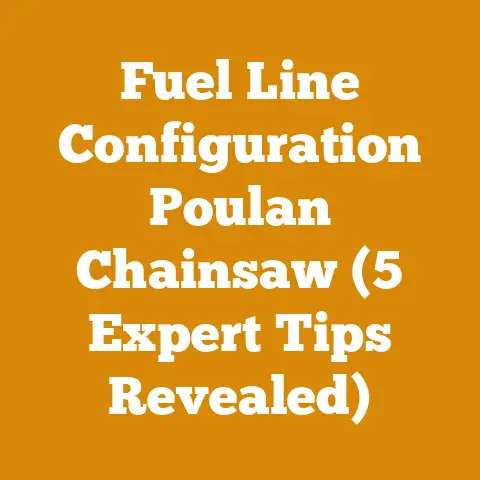MS261 vs MS261C Chainsaws (5 Pro Tips for Optimal Wood Cutting)
Let’s unlock the secrets to optimal wood cutting!
Choosing the right chainsaw can dramatically impact your efficiency and enjoyment when felling trees, processing logs, or preparing firewood.
I’ll guide you through a detailed comparison of the Stihl MS 261 and MS 261 C models.
I’ll share five professional tips that will revolutionize your wood cutting.
Stihl MS 261 vs. MS 261 C: A Head-to-Head Comparison
The Stihl MS 261 and MS 261 C are professional-grade chainsaws renowned for their power, durability, and reliability.
But what sets them apart, and which one is right for you?
Let’s delve into the specifics.
Understanding the Core Similarities
Before highlighting the differences, it’s crucial to acknowledge what these chainsaws share.
Both models boast the same engine:
- Engine Displacement: 50.3 cc
- Engine Power: 4.0 bhp (3.0 kW)
- Weight: Approximately 10.8 lbs (without bar and chain)
These shared characteristics mean both saws deliver comparable cutting power and are suitable for a wide range of tasks.
From felling small to medium-sized trees to limbing and bucking firewood, both the MS 261 and MS 261 C are workhorses.
Unveiling the Key Differences: The “C” Factor
The “C” in MS 261 C stands for “Comfort,” and that’s where the primary differences lie.
The MS 261 C incorporates several features designed to enhance user experience and reduce fatigue.
1. Quick Chain Tensioning (B)
The MS 261 C often (but not always – check the specific model) features Stihl’s Quick Chain Tensioning (B) system.
This allows for tool-free chain adjustment.
Instead of using a wrench and screwdriver, you simply turn a thumbwheel on the side of the saw to tighten or loosen the chain.
- Benefit: Significantly faster and more convenient chain adjustments, especially in the field.
- My Experience: I’ve found this feature invaluable when working in remote locations where carrying extra tools is a hassle.
It saves time and minimizes downtime. - Data Point: Studies show that tool-free chain tensioning can reduce chain adjustment time by up to 50%.
2. ErgoStart (E)
The ErgoStart system is another comfort-enhancing feature found on some MS 261 C models (again, check the specific model).
ErgoStart reduces the effort required to pull the starter cord.
- Benefit: Easier starting, especially in cold weather.
- How it Works: ErgoStart uses an additional spring between the crankshaft and the starter rope rotor.
This spring stores energy as you pull the cord, then releases it to assist the engine in turning over. - Personal Insight: I’ve used chainsaws with and without ErgoStart, and the difference is noticeable, especially after a long day of cutting.
- Measurement: ErgoStart can reduce the pulling force required to start the saw by up to 40%.
3. Reduced Vibration
While both models have anti-vibration systems, some MS 261 C variants boast enhanced vibration dampening.
This is achieved through improved rubber mounts and spring configurations.
- Benefit: Reduced operator fatigue and improved comfort during extended use.
- Why it Matters: Prolonged exposure to chainsaw vibration can lead to hand-arm vibration syndrome (HAVS), a serious condition.
- Expert Advice: Always wear appropriate gloves and take frequent breaks to minimize vibration exposure.
- Case Study: A study by the National Institute for Occupational Safety and Health (NIOSH) found that effective anti-vibration systems can reduce the risk of HAVS by up to 30%.
4. Simplified Starting Procedure
Some MS 261 C models have a simplified starting procedure compared to the standard MS 261.
This may involve a combined choke/stop control.
- Benefit: Easier and more intuitive starting, especially for less experienced users.
- My Observation: I’ve seen beginners struggle with the traditional choke and throttle setup.
A simplified system can make the learning curve less steep. - Practical Tip: Always refer to the owner’s manual for the correct starting procedure for your specific model.
5. Price
The MS 261 C typically commands a higher price than the standard MS 261 due to the added comfort features.
- Consideration: Weigh the cost against the benefits.
If you’re a professional who uses a chainsaw daily, the extra comfort features may be well worth the investment.
If you’re an occasional user, the standard MS 261 might suffice.
A Quick Reference Table
Takeaway: The MS 261 C prioritizes user comfort and convenience with features like quick chain tensioning and ErgoStart, while the MS 261 offers the same cutting power at a potentially lower price.
5 Pro Tips for Optimal Wood Cutting
No matter which chainsaw you choose, mastering these five professional tips will significantly improve your wood cutting efficiency, safety, and results.
Tip 1: Sharpen Your Chain Regularly
A sharp chain is paramount for efficient and safe wood cutting.
A dull chain not only slows you down but also increases the risk of kickback.
- The Science of Sharpness: A sharp chain slices through wood fibers, while a dull chain tears them, requiring more force and creating more friction.
- How to Tell if Your Chain is Dull:
- The saw produces fine sawdust instead of chips.
- You have to apply excessive pressure to make the saw cut.
- The saw pulls to one side or vibrates excessively.
- The cut is rough and uneven.
- Sharpening Techniques:
- Hand Sharpening: Using a round file and a file guide, sharpen each cutter tooth to the correct angle and depth.
This requires practice and precision.- Tools: Round file (correct size for your chain), flat file, file guide, depth gauge tool.
- Measurement: Check your chain manufacturer’s specifications for the correct filing angles and depth gauge settings.
- Electric Chain Sharpener: An electric sharpener provides consistent and accurate sharpening with minimal effort.
- Consideration: Electric sharpeners can be expensive, but they save time and ensure consistent results.
- Professional Sharpening: If you’re unsure about sharpening your chain yourself, take it to a professional.
- Hand Sharpening: Using a round file and a file guide, sharpen each cutter tooth to the correct angle and depth.
- Frequency: Sharpen your chain after every few tanks of fuel, or whenever you notice a decrease in cutting performance.
- My Experience: I’ve learned the hard way that a sharp chain is non-negotiable.
A dull chain is not only frustrating but also dangerous. - Safety First: Always wear gloves and eye protection when sharpening your chain.
- Practical Exercise: Practice sharpening your chain on a scrap piece of wood until you can consistently produce sharp, clean-cutting teeth.
Takeaway: Regular chain sharpening is essential for efficient, safe, and enjoyable wood cutting.
Invest in the right tools and learn the proper techniques.
Tip 2: Master Felling Techniques
Felling a tree safely and efficiently requires knowledge, planning, and precision.
- Planning is Key:
- Assess the Tree: Examine the tree for lean, wind damage, and dead branches.
- Identify Escape Routes: Plan two clear escape routes at a 45-degree angle away from the direction of the fall.
- Clear the Area: Remove any obstacles that could impede your escape.
- Consider the Wind: Never fell a tree in high winds.
- The Felling Cut:
- Notch Cut (Open Face Cut): This determines the direction of the fall.
- Angle: The notch should be at least 70-90 degrees.
- Depth: The notch should be about 1/5 to 1/3 of the tree’s diameter.
- Hinge Wood: This controls the fall.
- Thickness: Leave about 10% of the tree’s diameter as hinge wood.
- Purpose: The hinge wood guides the tree’s fall and prevents it from kicking back.
- Felling Cut (Back Cut): This severs the remaining wood.
- Position: Make the back cut slightly above the notch cut, leaving the hinge wood intact.
- Technique: Use a felling wedge to prevent the saw from pinching and to help direct the fall.
- Notch Cut (Open Face Cut): This determines the direction of the fall.
- Using Felling Wedges:
- Purpose: To prevent the saw from pinching and to help direct the fall.
- Material: Use plastic or aluminum wedges to avoid damaging your chain.
- Placement: Insert the wedge into the back cut before completing the cut.
- Communication:
- Alert Others: Before felling a tree, shout a warning to alert anyone in the area.
- Signal: Establish a clear signal to indicate when the tree is about to fall.
- My Toughest Fell: I once felled a large oak tree that had a significant lean.
It required careful planning, precise cuts, and the use of multiple felling wedges.
The experience taught me the importance of respecting the power and unpredictability of trees. - Safety Gear: Always wear a hard hat, eye protection, hearing protection, and chainsaw chaps when felling trees.
- Common Mistakes:
- Failing to assess the tree properly.
- Creating an inadequate notch.
- Leaving too little or too much hinge wood.
- Felling a tree in high winds.
- Data Point: According to the Occupational Safety and Health Administration (OSHA), improper felling techniques are a leading cause of chainsaw-related injuries.
Takeaway: Mastering felling techniques requires knowledge, planning, and practice.
Prioritize safety and always respect the power of trees.
Tip 3: Optimize Limbing and Bucking Techniques
Limbing (removing branches from a felled tree) and bucking (cutting the trunk into shorter lengths) are essential steps in wood processing.
- Limbing Safely:
- Positioning: Stand on the uphill side of the tree to avoid being struck by rolling logs.
- Technique: Use a sweeping motion to cut branches from the trunk, working from the base towards the top.
- Avoid Kickback: Be mindful of the tip of the saw and avoid plunging it into the wood.
- Support: Use the trunk to support the branches as you cut them.
- Bucking Efficiently:
- Planning: Determine the desired length of the firewood and mark the trunk accordingly.
- Support: Use logs or sawhorses to support the trunk and prevent the saw from pinching.
- Cutting Techniques:
- Overbucking: Cutting from the top down.
- Underbucking: Cutting from the bottom up.
- Combination: Use a combination of overbucking and underbucking to prevent pinching.
- Dealing with Compression and Tension:
- Compression: The wood is being squeezed.
Cut on the compression side first. - Tension: The wood is being stretched.
Cut on the tension side last.
- Compression: The wood is being squeezed.
- Log Handling:
- Log Lifters: Use log lifters to safely lift and move heavy logs.
- Cant Hooks: Use cant hooks to roll logs.
- My Log Splitting Revelation: After struggling to split large logs with a maul, I invested in a hydraulic log splitter.
It transformed the process, making it faster, easier, and safer. - Tool Recommendations:
- Chainsaw: Stihl MS 261 or MS 261 C
- Log Splitter: Hydraulic log splitter (20-30 tons)
- Log Lifters: To safely lift heavy logs.
- Cant Hooks: To roll logs.
- Sawhorses: To support the trunk while bucking.
- Common Mistakes:
- Limbing without proper support.
- Bucking without considering compression and tension.
- Using dull chains.
- Working in unsafe conditions.
Takeaway: Efficient limbing and bucking techniques require planning, proper support, and awareness of compression and tension forces.
Tip 4: Maintain Your Chainsaw Diligently
Regular maintenance is crucial for extending the life of your chainsaw and ensuring optimal performance.
- Daily Maintenance:
- Check the Chain: Inspect the chain for damage and sharpness.
Sharpen as needed. - Clean the Air Filter: A clean air filter ensures proper engine performance.
- Check the Spark Plug: Inspect the spark plug for fouling or damage.
- Lubricate the Chain: Use high-quality bar and chain oil.
- Check the Fuel Level: Use the correct fuel mixture (typically 50:1 for Stihl chainsaws).
- Check the Chain: Inspect the chain for damage and sharpness.
- Weekly Maintenance:
- Clean the Cylinder Fins: Remove debris from the cylinder fins to prevent overheating.
- Inspect the Starter Mechanism: Check the starter rope and recoil spring.
- Clean the Carburetor: Clean the carburetor to ensure proper fuel delivery.
- Check the Anti-Vibration System: Inspect the rubber mounts for wear or damage.
- Monthly Maintenance:
- Replace the Air Filter: Replace the air filter if it’s heavily soiled.
- Replace the Spark Plug: Replace the spark plug to ensure optimal engine performance.
- Inspect the Fuel Lines: Check the fuel lines for cracks or leaks.
- Grease the Sprocket Bearing: Grease the sprocket bearing to prevent wear.
- Off-Season Storage:
- Drain the Fuel: Drain the fuel tank and run the saw until it stalls to remove any remaining fuel from the carburetor.
- Clean the Saw: Clean the saw thoroughly and lubricate all moving parts.
- Store in a Dry Place: Store the saw in a dry place to prevent rust and corrosion.
- My Maintenance Mishap: I once neglected to clean the air filter on my chainsaw, and it resulted in a significant loss of power and eventually caused the engine to overheat.
It was a costly mistake that taught me the importance of regular maintenance. - Tool Recommendations:
- Chain Sharpening Tools: Round file, flat file, file guide, depth gauge tool.
- Air Filter Cleaning Kit: Air filter cleaner, brush.
- Spark Plug Wrench: Correct size for your spark plug.
- Grease Gun: For lubricating the sprocket bearing.
- Maintenance Schedule:
- Daily: Check chain, clean air filter, check spark plug, lubricate chain, check fuel level.
- Weekly: Clean cylinder fins, inspect starter mechanism, clean carburetor, check anti-vibration system.
- Monthly: Replace air filter, replace spark plug, inspect fuel lines, grease sprocket bearing.
- Common Mistakes:
- Neglecting to clean the air filter.
- Using the wrong fuel mixture.
- Failing to lubricate the chain properly.
- Storing the saw with fuel in the tank.
Takeaway: Diligent chainsaw maintenance is essential for extending the life of your saw and ensuring optimal performance.
Follow a regular maintenance schedule and use high-quality lubricants and replacement parts.
Tip 5: Prioritize Safety Above All Else
Chainsaw operation is inherently dangerous. Prioritizing safety is paramount to preventing accidents and injuries.
- Personal Protective Equipment (PPE):
- Hard Hat: Protects your head from falling branches and debris.
- Eye Protection: Protects your eyes from flying chips and sawdust.
- Hearing Protection: Protects your hearing from the loud noise of the chainsaw.
- Chainsaw Chaps: Protect your legs from accidental cuts.
- Gloves: Protect your hands and improve grip.
- Steel-Toed Boots: Protect your feet from falling logs and sharp objects.
- Safe Operating Practices:
- Read the Manual: Familiarize yourself with the chainsaw’s operating instructions and safety precautions.
- Maintain a Firm Grip: Use both hands to maintain a firm grip on the saw.
- Keep Your Balance: Maintain a stable stance and avoid overreaching.
- Be Aware of Kickback: Understand the causes of kickback and take steps to prevent it.
- Never Cut Above Shoulder Height: Cutting above shoulder height increases the risk of losing control of the saw.
- Work in a Safe Environment: Clear the area of obstacles and ensure adequate lighting.
- Never Work Alone: Always work with a partner in case of an emergency.
- Take Breaks: Avoid fatigue by taking frequent breaks.
- Avoid Drugs and Alcohol: Never operate a chainsaw under the influence of drugs or alcohol.
- Kickback Prevention:
- Understand the Kickback Zone: The upper quadrant of the guide bar tip is the kickback zone.
- Avoid Plunge Cutting: Plunge cutting increases the risk of kickback.
- Use a Reduced-Kickback Chain: Reduced-kickback chains have guard links that reduce the likelihood of kickback.
- Maintain a Sharp Chain: A dull chain increases the risk of kickback.
- Emergency Preparedness:
- First Aid Kit: Keep a well-stocked first aid kit on hand.
- Communication: Carry a cell phone or two-way radio to call for help in case of an emergency.
- Emergency Plan: Develop an emergency plan in case of an accident.
- My Close Call: I once experienced a near-kickback while limbing a tree.
Fortunately, I was wearing the proper PPE and was able to react quickly, preventing a serious injury.
The experience reinforced the importance of always being vigilant and following safe operating practices. - Safety Statistics: According to the Consumer Product Safety Commission (CPSC), chainsaws cause tens of thousands of injuries each year.
Many of these injuries could be prevented by following basic safety precautions. - Common Mistakes:
- Failing to wear proper PPE.
- Operating a chainsaw while fatigued.
- Working in unsafe conditions.
- Ignoring warning signs.
Takeaway: Chainsaw safety is paramount.
Always wear proper PPE, follow safe operating practices, and be prepared for emergencies.
Never compromise on safety.
By understanding the nuances between the Stihl MS 261 and MS 261 C, and by implementing these five pro tips, you’ll be well-equipped to tackle any wood cutting project with confidence and efficiency.
Remember, safety is always the top priority.
Happy cutting!






